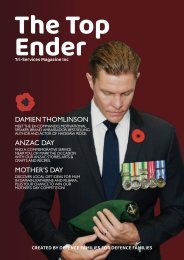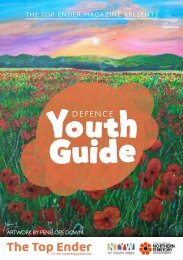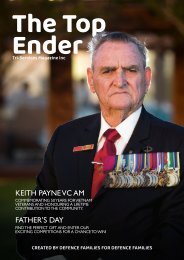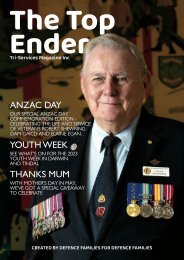The Top Ender Magazine February March 2021 Edition
You also want an ePaper? Increase the reach of your titles
YUMPU automatically turns print PDFs into web optimized ePapers that Google loves.
$100<br />
COMMUNITY<br />
CONTRIBUTOR<br />
VOUCHER<br />
Together, the Royal Australian Air Force, the Australian Army and the Royal<br />
Australian Navy form the Australian Defence Force, an organisation woven<br />
into the fabric of our society. Despite a global pandemic the services each<br />
celebrate significant birthdays in <strong>2021</strong>, with its soldiers, sailors and airmen<br />
and women deployed on the front line domestically and abroad.<br />
<strong>The</strong> Royal Australian<br />
Air Force celebrates 100 years in the air<br />
Celebrating its 100th birthday on 31 st <strong>March</strong> <strong>2021</strong>, Australia’s<br />
involvement in the air began with the formation of the<br />
Australian Aviation Corps in 1911 with a Flying School<br />
opened at Point Cook, Victoria in 1912. In 1914 the Corps<br />
was renamed the Australian Fly Corps. In the First World<br />
War the Australian Flying Corps fought in support of the<br />
Indian Army during the Mesopotamian Campaign in today’s<br />
Iraq against the Ottoman Empire, and later in Egypt, Palestine<br />
and the Western Front. In the inter-war years, the Australian<br />
Air Corps was formed in 1920 and in 1921, the Royal<br />
Australian Air Force (RAAF) was born.<br />
During the Second World War, thousands of Australians<br />
served with Commonwealth Air Forces, most notably the<br />
Royal Air Force in the European theatre. <strong>The</strong> Second World<br />
War and Japan’s rapid advance in the pacific saw the<br />
threatening of mainland Australia for the first time in its<br />
history. Despite devastating air raids on Darwin, the RAAF<br />
played a crucial role in the Solomon Islands and New<br />
Guinea campaigns, the latter in which the RAAF was<br />
instrumental in inflicting the first decisive victory by allied<br />
forces over the Japanese of the war.<br />
RAAF pilots and aircraft were amongst the first to fly combat<br />
missions in the Korean War and later served in the Malayan<br />
Emergency and the Vietnam War. <strong>The</strong> RAAF continues to<br />
provide a presence in Malaysia based out of the now Royal<br />
Malaysian Air Force Base at Butterworth. RAAF combat<br />
aircraft were again used during the 2003 Iraq War and the<br />
RAAF would maintain a presence in the Middle East,<br />
sustaining operations in Afghanistan and Iraq for over a<br />
decade. In 2014 RAAF deployed an Air Task Group to the<br />
Middle East as part of the global coalition to combat the<br />
Islamic State in Iraq and Syria. In 2017, RAAF Maritime Patrol<br />
Aircraft supported the Philippines during the Marawi Crisis.<br />
<strong>The</strong> RAAF personnel and aircraft have provided regular<br />
Humanitarian Assistance and Disaster Relief both<br />
domestically and abroad including Aero-Medical Evacuations<br />
following the Bali Bombing in 2002 and 2005; the 2004<br />
Boxing Day Tsumani; the 2011 Queensland Floods, Cyclone<br />
Yasi, Christchurch Earthquake and Japan Earthquake; and,<br />
various cyclones in Fiji, Vanuatu and the Philippines to name a<br />
few. Of note, the RAAF has been involved in global<br />
operations in response to accidents and disasters including<br />
the search for MH370 and the repatriation of Australians<br />
after the shooting down of MH17. <strong>The</strong> RAAF continues to<br />
provide support on a global scale in response to disasters<br />
and as part of military operations.<br />
<strong>The</strong> Australian Army celebrates 120 years<br />
On 1st <strong>March</strong> <strong>2021</strong> the Australian Army celebrates 120 years<br />
of dedicated service to the nation. Formed in 1901 through<br />
the amalgamation of the six state Colonial Military Forces<br />
following the federation of Australia, it would only be 14<br />
short years until the Australian Army, and the nation, would<br />
face its first true test of quality. <strong>The</strong> character traits of<br />
Courage, Mateship and Sacrifice shown in the trenches of<br />
Gallipoli would see the birth of the ANZAC legend with the<br />
spirit of ANZAC becoming firmly embedded in the attitudes<br />
of all Australians. Australian soldiers would later go on to<br />
serve in combat during the Second World War, the Korean<br />
War, Vietnam and Iraq and Afghanistan, developing a<br />
reputation across the world as highly respected, capable and<br />
professional force.<br />
<strong>The</strong> Australian Army’s capability, however, is not limited to<br />
times of conflict. Its officers and soldiers have served with<br />
distinction in peacekeeping restoring and maintaining<br />
stability in Bougainville, East Timor and the Solomon Islands<br />
and continues to deploy peacekeepers to Israel, Mali, the<br />
Sinai, and South Sudan.<br />
Over its 120 year history, the Australian Army has come to<br />
be relied upon to give humanitarian support in response to<br />
120 years at sea – <strong>The</strong> Royal Australian Navy<br />
turns 120<br />
Initially formed as the Commonwealth Naval Forces on 1st<br />
<strong>March</strong> 1901, following the federation of Australia with the<br />
integration of the Colonial Navies’ ships and resources, it was<br />
renamed the Royal Australian Navy in 1911. As with the<br />
Army, the Royal Australian Navy served under British Imperial<br />
command during the First World War operating in the<br />
South Pacific and later the Mediterranean and North Seas.<br />
<strong>The</strong> interwar years saw a dramatic decrease in the size of the<br />
fleet and a shift in focus from defence against invasion to<br />
protection of trade routes.<br />
<strong>The</strong> outbreak of the Second World War again saw the Royal<br />
Australian Navy fall under British command with its sailors<br />
serving with distinction in areas such as the Mediterranean,<br />
Persian Gulf and the Indian Ocean. <strong>The</strong> outbreak of war in<br />
the pacific following the destruction of the allied navy in<br />
South-East Asia saw the Royal Australian Navy begin to<br />
operate more independently or as part of fleets from the<br />
natural disasters at domestically and abroad. At home, fulltime<br />
and reserve soldiers were ever present in the clean-up<br />
and rebuild following Cyclone Yasi and the Queensland<br />
Floods in 2011, Cyclone Debbie in 2017 and the 2020<br />
Victorian and South Australian Bushfires. Likewise, overseas<br />
our soldiers have deployed to areas such as Banda Aceh,<br />
Indonesia in response to the 2004 Indian Ocean Earthquake<br />
providing critical aid to our near region neighbours and again<br />
in 2020 to Fiji following Cyclone Yasa.<br />
In 2020 the Australian Army deployed domestically to<br />
support local communities combat the Coronavirus<br />
pandemic ensuring the integrity of state border closures and<br />
working with State and Federal Police supervising quarantine<br />
facilities, an operation ongoing today.<br />
United States Navy in the pacific. 2020 was a significant year<br />
for the Royal Australian Navy with the posthumous<br />
awarding of the Victoria Cross to Ordinary Seaman Edward<br />
“Teddy” Sheean, the first Navy crew member to be awarded<br />
Australia’s highest honour Australian Navy. Teddy Sheean<br />
was killed in action with the sinking of the HMAS Armidale on<br />
1st December 1942 after defying orders to abandon ship,<br />
instead strapping himself to an anti-aircraft gun and continually<br />
engaging Japanese bombers despite being wounded.<br />
Following the Second World War, the Royal Australian Navy<br />
again served with British and American sailors as military<br />
operations in Korea, Malaysia, Vietnam and the Persian Gulf<br />
and Indian Ocean. Alongside the Australian Army, the Navy<br />
has deployed on peacekeeping operations in East Timor and<br />
the Solomon Islands.<br />
An integral element of Australia’s Humanitarian Assistance<br />
and Disaster Relief capability, the Royal Australian Navy has<br />
regularly provided assistance to nations within our near region<br />
including the 2004 Boxing Day Tsunami, the 2005 Banda<br />
Aceh Earthquake and various Cyclones in the Philippines,<br />
Vanuatu, Fiji and Australia. <strong>The</strong> Royal Australian Navy<br />
continues to deploy ships to the Middle East Region as part of<br />
international efforts to ensure maritime security and counter<br />
piracy. Since 2006, the Royal Australian Navy has been a<br />
leading contributor to Australian Border Protection<br />
operations continually deploying ships and personnel against<br />
threats of illegal maritime arrivals and illegal activity in<br />
protected waters amongst others.<br />
46 <strong>The</strong> <strong>Top</strong> <strong>Ender</strong> | Tri-Services <strong>Magazine</strong> Incorporated FEBRUARY/MARCH <strong>2021</strong> 47


















